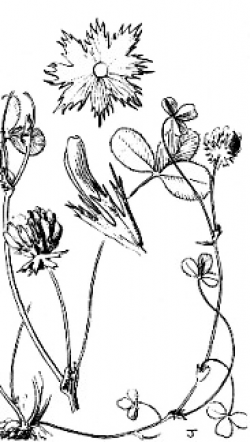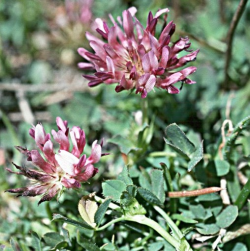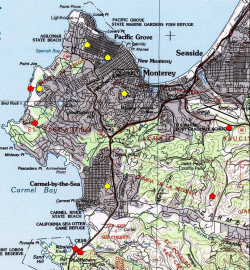
endangered

Illustration from Abrams (1944)

Photo taken on 17 Mile Drive by Dean W. Taylor

A red polygon indicates an extant occurrence; yellow indicates the occurrence has been extirpated



This fact sheet was prepared by Grey F. Hayes and Dean W. Taylor under award NA04N0S4200074 from the National Oceanic and Atmospheric Administration (NOAA), U.S. Department of Commerce (DOC). The statements, findings, conclusions, and recommendations are those of the authors and do not necessarily reflect the views of the NOAA or the DOC.
© Copyright 2006, Elkhorn Slough Coastal Training Program
Last updated: Jul 21, 2006 10:03
Common Names - Pacific Grove clover
Family - Fabaceae (Legume Family)
State Status - state rare
Federal Status - none
Habitat
In vernally moist swales in coastal prairie, or vernally moist dune hollows, often on the edges of old roadbeds
Key Characteristics
Annual or short-lived perennial, decumbent herb, stems from 1–2 dm long, sparingly branched, glabrous, somewhat fleshy; lower stipules entire, upper laciniate; leaflets 3, obovate, ca. 10–16 mm long and ca. 7 mm wide at most; inflorescence involucrate, capitate with up to 50 flowers; involucre rotate; calyx tube 3–10 mm long, >10 veined, some or all of the lobes generally = tube, divided with 2 lateral serrations, and with a minute terminal bristle; corolla lavender, the keel often purple and the tips of the wings and banner often pinkish-white; pods with 1–2 seeds. One of several members of the T. variegatum complex, which includes T. buckwestiorum, T. appendiculatum, and T. subsalinum. Very similar in habit and general appearance to T. wormskioldii, which is common in our region; it is a strong perennial with larger leaflets, larger heads, and 3–4 seeds/pod.
Flowering Period
April to June
Reference Populations
17 Mile Drive, Pt. Lobos State Reserve (Monterey County)
Global Distribution
Endemic to Monterey and Santa Cruz counties
Conservation
Trifolium polyodon corresponds to the so-called “phase 4” of T. variegatum in The Jepson Manual (1993). Until the discovery of the two Santa Cruz Co. populations (just above and below the UCSC campus) in 1999 and 2002, this species was believed to be endemic to the Monterey area. In 1994, approximately 45,000 plants were counted at 11 sites (Jones & Stokes 1996) in Monterey County—one small occurrence at Asilomar State Beach is nearly extirpated; larger occurrences are on Lobos Ranch (Big Sur Land Trust), Santa Lucia Preserve, and many sites occur on 17 Mile Drive and vicinity.
A closely related, unpublished (and quite rare) variety was discovered in the Scotts Valley grasslands and later found near Boulder Creek in Santa Cruz County, and single disjunct sites in Sonoma and Marin counties. These plants key to T. variegatum var. variegatum in The Jepson Manual, Second Edition, but (in living plants) the flower color resembles that of T. polyodon. Differs from typical T. p. in having calyx lobes simple, rather than forked. It also grows in wetter habitats and flowers later (R. Morgan, personal communication).
References
Abrams, L. 1944. Illustrated Flora of the Pacific States, Vol. 2. Stanford University Press, Palo, Alto, CA.
Jones and Stokes Associates, Inc. 1996. Recovery Strategies for Six Coastal Plant Species on the Monterey Peninsula. Monterey, CA.
Morgan, R. Personal communication (23 January 2015).
